Archived Fire Damage Blog Posts
Efficient and Comprehensive Fire Restoration
2/27/2025 (Permalink)
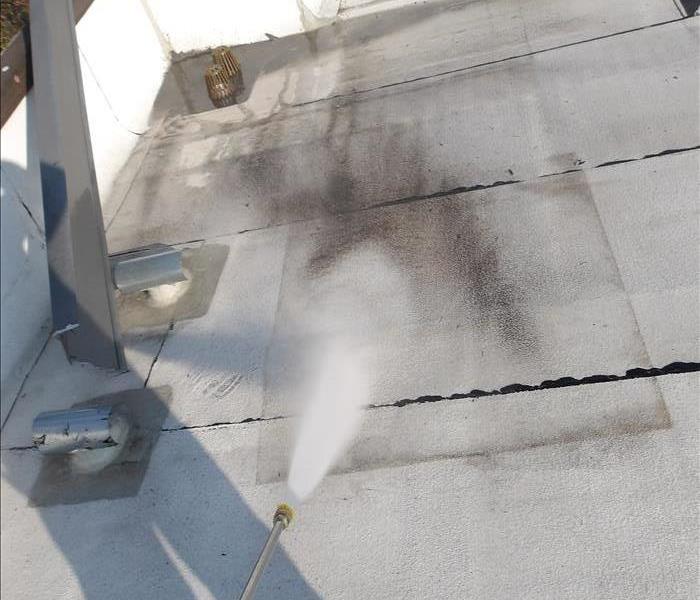 Wildfire in Altadena
Wildfire in Altadena
The damage is not just confined to the flames. Smoke, soot, and ash can spread throughout your home, making the restoration process crucial to ensuring that your home is not only safe but also comfortable to live in again. At SERVPRO of Central Glendale, we understand that every minute counts when it comes to fire damage, which is why we move swiftly to restore your property to its original condition.
1. Tackling the Ashes: A Thorough Exterior Cleanup
The first step in our fire restoration process focuses on the outside of your home. While most of the ashes and debris will be located outside if the fire was near the property, it’s essential that we remove every trace of soot and dirt to avoid long-term damage. We use pressure washers to clean the exterior thoroughly, ensuring that nothing is left behind. Our team works quickly and efficiently, making sure that your home’s outside structure is restored to its original state.
2. Assessing and Cleaning the Interior
Once the exterior is cleaned, we move inside. If the fire originated inside the house, we start the restoration process at the site of the origin. However, we don’t stop there. We conduct a thorough assessment of the entire property to ensure no area is overlooked. Our goal is to restore the entire home "like it never happened."
To address the various residues left by the fire, we perform both dry and wet cleaning (if necessary). These methods help to lift smoke and soot from surfaces, ensuring that your belongings and the structure of your home are free of contaminants.
3. Eliminating Smoke and Odor
One of the most challenging aspects of fire damage is the lingering smell of smoke. It can be tough to breathe in, and it sticks to almost everything. Fortunately, SERVPRO of Central Glendale has specialized chemicals and machines designed to eliminate smoke odors effectively. Our team uses industrial-grade equipment to purify the air and treat fabrics, furniture, and other affected surfaces, ensuring your home smells fresh and clean once again.
4. Why SERVPRO?
At SERVPRO of Central Glendale, we pride ourselves on our quick response and comprehensive approach to fire restoration. We understand that a fire can be devastating, but with the right professionals by your side, you can rest assured that your home will be restored to its original condition.
We don’t just focus on fixing the visible damage; we ensure that your entire home is safe, comfortable, and ready to welcome you back. With years of experience, equipment, and a commitment to customer satisfaction, SERVPRO is here to help when you need it most.
From Soot to Clean
1/3/2025 (Permalink)
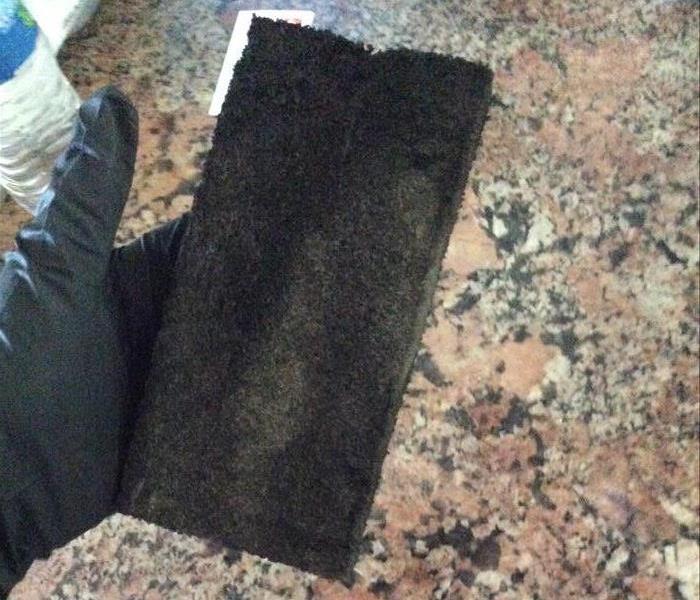 Soot has a smoky odor and can settle on any surface, including walls, ceilings, vents, furniture, and fabrics.
Soot has a smoky odor and can settle on any surface, including walls, ceilings, vents, furniture, and fabrics.
Experiencing a fire in your home or business can be devastating. Not only can it cause immediate structural damage, but it also leaves behind a trail of soot, smoke, and lingering odors that are difficult to remove. If you've been affected by a fire, it’s crucial to seek professional help for the restoration process. SERVPRO of Central Glendale is trained to handle fire damage and restore your property to its preloss condition. Here’s how we can help.
What Soot Can Do: After a fire, soot is one of the most common and harmful residues left behind. Soot is essentially the byproduct of smoke that settles on surfaces throughout your property. This black, powdery residue can cause significant damage if not addressed promptly. Here’s what soot can do to your property:
- Discoloration: Soot can cause unsightly stains on walls, ceilings, furniture, and carpets. If left untreated, these stains can become permanent, leading to costly repairs or replacements.
- Corrosion: Soot may contain various acids that can corrode metal, electrical components, and appliances, potentially causing long-term damage.
- Health Hazards: Soot particles can be harmful to your health if inhaled. This is why it’s important to work with professionals who are equipped with the proper safety gear, such as gloves, masks, and suits.
Different Types of Soot: Not all soot is created equal. The type of soot that settles in your home depends on the nature of the fire, and each type requires specific cleaning methods. Here’s a breakdown of the different types of soot and their impact:
- Furnace Puff-back Soot: This type of soot is caused by incomplete combustion of fuel oil in heating systems, particularly from ductwork. Furnace puff-back soot can be easily removed if cleaned right away. If left for a prolonged period, however, it may require repainting due to the potential for discoloration.
- Dry Soot: Dry soot is typically less stubborn and doesn't stain surfaces as deeply. It often comes from smaller, cooler fires. Dry soot is easier to clean, and the affected materials are more likely to be restorable. While the odor may be less intense, it still requires proper treatment to remove lingering smells.
- Wet Soot: Wet soot is more dangerous and difficult to clean. It moves slowly, contaminating areas that wouldn’t usually be affected by smoke, and causes discoloration on materials like plastic almost instantly. Wet soot is much harder to restore, and unfortunately, contents exposed to it are often considered unsalvageable.
- Protein Residues: Protein-based residues, caused by burning organic matter like meat or poultry, are often less visible but still pose challenges. These residues can cause slight discoloration on walls, cabinets, and other surfaces. The smell can be particularly difficult to remove, requiring deep cleaning to fully address the odor and ensure the property is restored.
SERVPRO’s Restoration Process: When it comes to fire damage, time is of the essence. At SERVPRO of Central Glendale, we understand the emotional and financial toll that fire damage can take. That’s why we act fast, using advanced techniques and equipment to restore your property as quickly as possible. Our restoration process includes:
- Assessment and Inspection: Our technicians will assess the extent of the damage and identify the type of soot and smoke present. We use specialized equipment to measure and evaluate the damage.
- Safety First: Fire restoration requires a focus on safety. Our team is equipped with personal protective equipment (PPE), including gloves, masks, and protective suits, to prevent exposure to harmful chemicals and soot.
- Soot and Smoke Removal: We use industry-leading techniques to remove soot and smoke from all surfaces. Whether it's dry soot, wet soot, or protein residues, our team is skilled in using the right methods for each type.
- Odor Removal: After the visible damage is taken care of, we tackle the lingering odors. Using air scrubbers and specialized smoke odor removal techniques, we eliminate smoke smells from furniture, fabrics, and other porous materials.
- Restoration and Cleanup: Once soot and odors are addressed, we proceed with cleaning and restoring your home or business to its preloss condition. This includes cleaning carpets, upholstery, and contents, as well as repainting and repairing surfaces where necessary.
Why Choose SERVPRO of Central Glendale? SERVPRO of Central Glendale is your trusted partner in fire damage restoration. Here’s why:
- Experience: We have years of experience dealing with all types of fire damage, from minor soot stains to large-scale fire restoration projects.
- 24/7 Emergency Response: We’re available around the clock to provide immediate assistance whenever disaster strikes.
- Comprehensive Services: We handle every aspect of the process from initial cleanup to final restoration.
A fire can be overwhelming, but with the right restoration company, you can begin to rebuild your life. SERVPRO of Central Glendale is here to help you navigate the recovery process and restore your home to its former glory. If you’ve experienced fire damage, don’t wait—contact us today for professional soot, smoke, and odor removal services.
For immediate assistance, call SERVPRO of Central Glendale. We’re Here to Help® you recover from fire damage and make your home feel like home again.
Fire Damage and What To Do Next
2/3/2023 (Permalink)
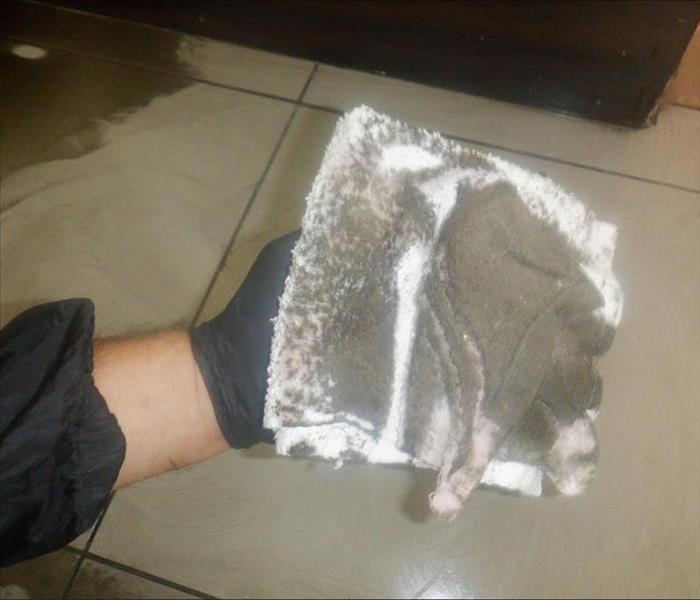 When a fire happens, our team has the tools and commercial cleaning solutions to restore your home.
When a fire happens, our team has the tools and commercial cleaning solutions to restore your home.
The causes of a fire
Fire damage is a devastating reality for many people and can cause significant physical, emotional, and financial losses. It is important to be aware of the potential for fire damage and the best ways to prepare for, respond to, and recover from such an event. All the damage from a fire can be caused by a variety of sources, including natural disasters, electrical problems, and human error. The most common cause of fire damage is accidental, resulting from a failed electrical system, faulty appliances, or improper use of flammable materials. In addition, natural disasters such as wildfires and tornadoes can cause extensive fire damage.
The effects of fire damage
The effects of fire damage can be far-reaching and can vary depending on the size and intensity of the fire. Structures, such as homes and businesses, can be destroyed, while smaller items, such as personal belongings, can be damaged or destroyed. The smoke and fumes created by fire may be dangerous for you, your family, and your pets. In addition, fire can cause serious damage to the environment, including air and water pollution.
The most important step in preventing fire damage is to take proper precautions. Homeowners should ensure that their electrical systems are up-to-date and inspect for any potential hazards. Businesses should regularly check and maintain fire safety equipment, such as fire extinguishers and smoke detectors, and ensure that all personnel is trained in the proper use and maintenance of such equipment. In addition, it is important to ensure that flammable materials are stored properly and away from any potential sources of heat or sparks.
What to do and how to recover
In the event of a fire, it is important to call the fire department immediately and evacuate the premises. If safe to do so, it is important to attempt to extinguish the fire before it spreads. However, if the fire is too large or is spreading quickly, it is best to leave the area and allow the fire department to handle the situation.
The recovery process following a fire can be extensive and costly. It is important to contact your insurance company immediately to report the fire and begin the claims process. Additionally, you should contact a fire damage restoration company to assess the damage and begin the cleanup process. The restoration company will be able to provide the necessary services to restore the affected area and items to their pre-fire condition.
Call Glendale’s top restoration company
In conclusion, fire damage is a serious issue that can have devastating effects. It is important to be aware of the potential for fire damage and take the necessary steps to prevent it. In the event of a fire, it is important to call the fire department and evacuate the premises. Finally, it is important to contact a fire damage restoration company like SERVPRO® of Central Glendale to begin the cleanup and restoration process. Give us a call today at 818-246-2200 to schedule an inspection.
Things You Should Know in a Recent Fire
12/5/2022 (Permalink)
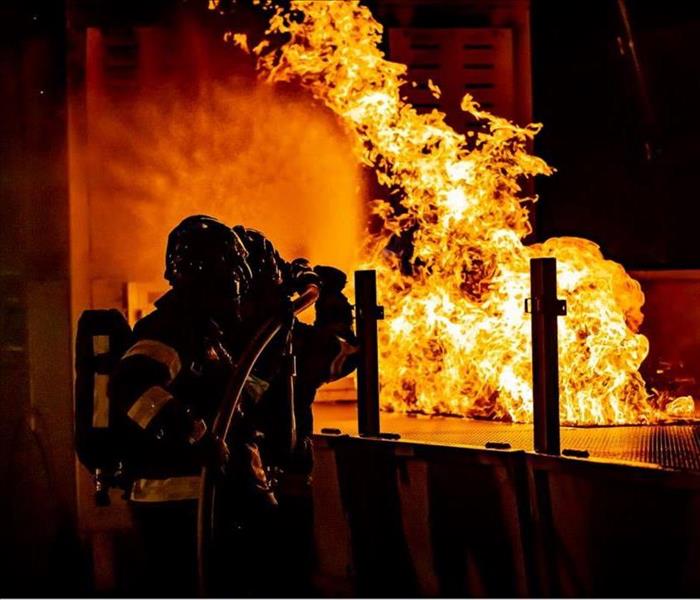 Try these important things to do (and not to do) during a fire.
Try these important things to do (and not to do) during a fire.
After any fire damage situation, your primary focus should be safety first.
Even if the situation is hectic, there are important questions to ask yourself for the safety of you and your family:
- Is it safe to enter the home?
- Is it safe to stay in the house?
- Electrical and "slip and fall" hazards are some of the most prevalent concerns. Are there electric outlets that are sparking?
- Only do activities that are safe for you to perform. Is it safe to do so?
- Wet materials can be weighty, is it too heavy to carry or pick up?
What To Do After a Fire
If you have had a recent fire, here are a few crucial things you should act on immediately:
- Limit movement in the home to prevent soot particles from being embedded into upholstery and carpets.
- Keep hands clean so as not to further soil upholstery, walls, and woodwork.
- Place clean towels or old linens on rugs, upholstery, and carpet traffic areas.
- If the electricity is off, empty the freezer and refrigerator and prop the doors open.
- Clean and protect chrome with light coating of petroleum jelly or oil.
- Wash houseplants on both sides of the leaves.
- Change the HVAC filter.
- Tape double layers of cheesecloth over air registers.
What NOT To Do After a Fire
As tempting as it may be, under no circumstances should the following things be done:
- Please don't attempt to wash any walls or painted surfaces or shampoo carpet or upholstery without contacting us.
- Don't attempt to clean any electrical appliances that may have been close to fire, heat or water without consulting an authorized repair service.
- Don't use any canned or packaged food or beverages that may have been stored near the fire, heat or water.
- Don't turn on ceiling fixtures if the ceiling is wet. The wiring may be damaged.
- Don't send garments to an ordinary dry cleaner. Improper cleaning may set smoke odor.
Have Smoke or Fire Damage? Call SERVPRO of Central Glendale today at 818-246-2200. Our expert and certified technicians are on standby.
The Most Important Facts About Fire Damage
10/20/2022 (Permalink)
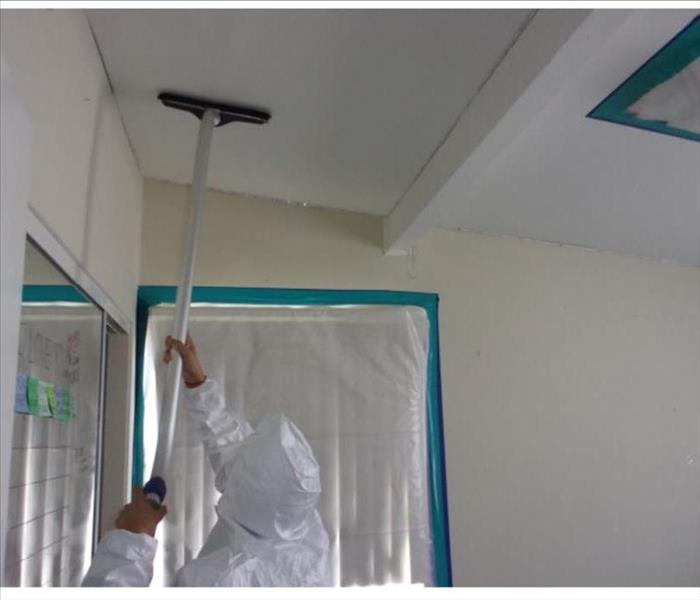 Our certified fire damage services are available to you 24 hours a day.
Our certified fire damage services are available to you 24 hours a day.
Fire can be terrifying there’s no doubt about it.
Fire damage falls into a severe type of property damage category. This is because it involves damage from flames, smoke, and water used to put out the fire.
Prevention is essential when it comes to avoiding these situations. This means well-maintained fire detectors and charged batteries. Be sure to routinely check the fire detector system and batteries regularly. You won’t regret the extra effort on your part.
Unfortunately, fires still happen even in the safest and most well-prepared properties. We recommend creating an escape plan set out for your family or employees.
Create a plan for every room in the house and/or office, and your family and staff should be able to respond immediately regardless of where they are in the building. This post looks at a few vital facts about fire and smoke damage restoration.
FIRE AND SMOKE DAMAGE RESTORATION SERVICES
Fire restoration businesses like SERVPRO® of Central Glendale are run by professionals who deal in restoring a property to its previously undamaged state. We are Glendale, California’s experts who deal with hundreds of homes and business facilities damaged by fire. We are ready, willing, and able to react as soon as you give us a call. Usually working 24/7 all year round, we can help you get your home or commercial building back to normal.
The first move we will make will be visiting your property and inspecting the damage to create an estimate and scope of work for the repairs and restoration needed. We will also share a detailed assessment and explanation of the repair process, so you understand every step. Fire restoration companies can coordinate with insurance companies and be there with any information they need.
Of course, some things can’t be repaired or aren’t worth the effort and the cost. A reputable fire damage restoration company like us will make this clear to you and your insurance adjuster.
THE DAMAGE FROM FIRE AND SMOKE
The first course of action for fire restoration services is to ensure the property’s foundation and structure are both secure and perform any emergency repairs to prevent secondary damage. Cleaning up after a fire is almost impossible without professional help.
The team will then remove any standing water, via extraction methods, and eliminate moisture in the affected areas by utilizing dehumidification processes. Then the smoke and soot will need to be managed.
Smoke from a fire contains a dangerous mixture of chemicals and toxins that can be harmful to your health, as well as your property.
And smoke damage cleanup is complicated. Inhaling smoke can be damaging to your lungs, and smoke will not only leave a dreadful odor, but it can also cause discoloration and corrosion of materials that will be extremely difficult to remedy.
The extent of the smoke damage is often due to the smoke’s origin, be it wet, dry, protein and/or fuel or oil.
- As a result of low heat, wet smoke is exceedingly difficult to clean.
- A fire at hot temperatures will result from a fast-burning fire.
- Invisible, protein smoke will cause the most discoloration to varnishes and has a nasty odor.
- As a result of a furnace malfunction, fuel-oil smoke will create soot.
Glendale’s Fire Damage Restoration Experts
If you have been dealing with a recent fire and fire damage to your property, you don’t have to go at it alone. If you need assistance, give us a call at 818-246-2200 anytime 7 days a week. Fire damage can strike at any time, and we are ready to restore 24 hours a day.
Glendale, CA Restaurant Suffers Fire Damage
9/21/2022 (Permalink)
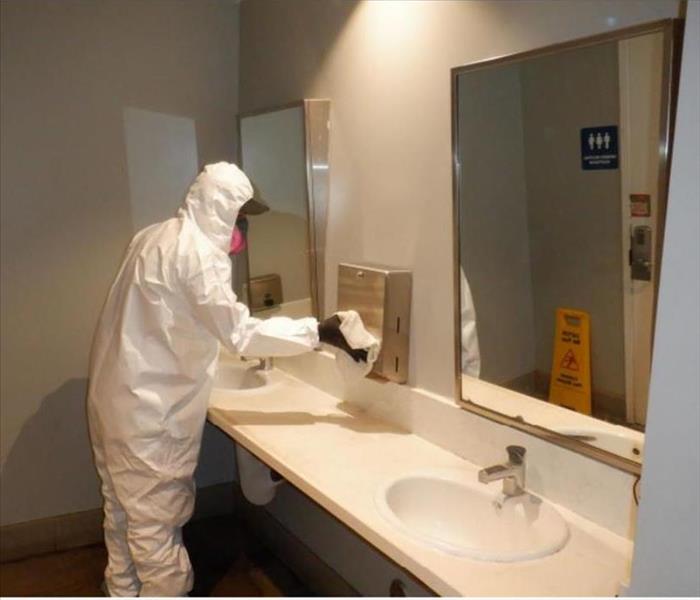 Our fire damage technicians understand how to get rid of soot and ash completely.
Our fire damage technicians understand how to get rid of soot and ash completely.
Local Fine Dining Eatery in Flames
SERVPRO® of Central Glendale is always happy to help local businesses in the surrounding areas with any water or fire damage that may occur. That is exactly what happened to a local restaurant near the Glendale Galleria. The kitchen caught fire, which forced smoke to spread into the vents. It was good that our trained fire technicians got there just in time to reverse the damage early.
The entire fine dining establishment was affected, unfortunately. What was worse, the fire happened during business hours with customers in the restaurants. Once the restaurant guests were safely evacuated, the city’s fire department put the fire out. The owner, understandably distraught, did not know what to do. Our project manager explained the process and helped him every step of the way. He answered all his questions and recommended our SERVPRO® crew begin removing the ash and suit immediately. The property owner agreed, signed paperwork with us, and our fire techs got to work.
Our Fire Technicians Work Fast
First, the crew split up into two teams – one team to tackle all the water left by the fire department that extinguished the fire and another to work on clearing out the vents and wiping up ash and soot. The first team extracted all the dirty water that was on the floor and all over the stoves and ovens. It can get messy when water hits a fire, since it smudges. SERVPRO®’s formulated cleaning materials cut the time in half when deep cleaning a surface.
Since ash and suit smear, it takes commercial-grade solutions to remove it. In our experience, one wipe just does not cut it. Once surfaces are wiped down, suit and ash tend to settle back onto it. Because of this, our crew wiped all areas of the affected restaurant two to three times to confirm it was gone entirely.
Within 5 days, the entire establishment was like new again. The owner was thrilled since her business was not closed for too long and they opened their days just in time for the weekend rush. We are happy that she decided to give us a call, we were able to show her that fire damage can disappear when our team is involved.
Call Your Local SERVPRO®
If you live in the Los Angeles or San Fernando area and have experienced a fire, do not panic. Call our expert fire damage staff at 818-246-2200 today to see how we can help you. The sooner you deal with fire damage, the less expensive it will be.
How To Deodorize A Smoky Residence
9/16/2022 (Permalink)
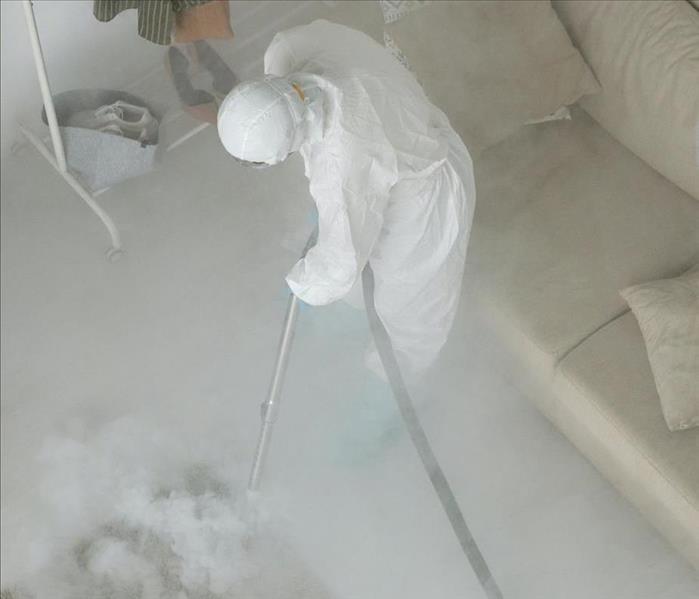 Fogging is one of the tactics our professionals use to remove smoke damage from your property.
Fogging is one of the tactics our professionals use to remove smoke damage from your property.
Getting Rid of the Smell
Home deodorization after a fire can be tricky to handle by yourself. Especially if you are dealing with smoke odor. There are “odor-eliminating” products that you can purchase at a local market, but beware. Short-term solutions can trick you into thinking you have removed the odor, however the truth is it only lasts for a day or two. Not all permanent solutions work for every situation.
Our staff here at SERVPRO® of Central Glendale have outlined a few “fix-it quick” solutions for the strong smell until we are able to deodorize your entire Glendale, California home. Please note this list does not include smoke residue that goes hand in hand with smoke.
Temporary Solutions
When dealing with strong, lingering odors, it is important to remove the particulates that are causing the smell rather than simply covering them up with other fragrances. The following are some common items that may cover up an odor for a bit:
- Air fresheners
- Oils
- Candles
- Sprays (like Febreze)
- Incense
Please understand the nice smelling aroma from these items will eventually fade and the smoke odor will come back. In some cases, the fragrance from the air freshener may combine with the smoke smell and create an even more unpleasant odor.
Permanent Smoke Removal
Whether from a fire or cigarette smoke, smoke odor is a very long-lasting problem. The particulates tend to get trapped in porous and non-porous surfaces and give off an unpleasant smell until they are properly removed. Fortunately, our SERVPRO® team have several methods of home deodorization that can effectively handle smoke odor:
- Air scrubbing (filters the smoke particles out of the air)
- Ozone treatment
- Thermal fogging
What Is an Ozone Treatment?
Ozone treatments allows ozone into the area. It combines with the smoke particles to form a new particle that does not produce a smoky odor. Thermal fogging is better for areas affected by fires where the high temperatures caused surfaces to expand and trap the smoke odor. A certified restoration service can help you choose the best odor removal method for your home.
Let the Odor Removing Pros Help
Home deodorization is often frustrating, especially if the offending smells linger for long periods or reappear. The best deodorization methods are those that permanently remove or alter the smoke particles so that they no longer emit unpleasant odors. To schedule a smoke odor removal session, give our Glendale office a call at 818-246-2200 and speak to one of our experts today.
Fire Damage Can Get Soggy
7/22/2022 (Permalink)
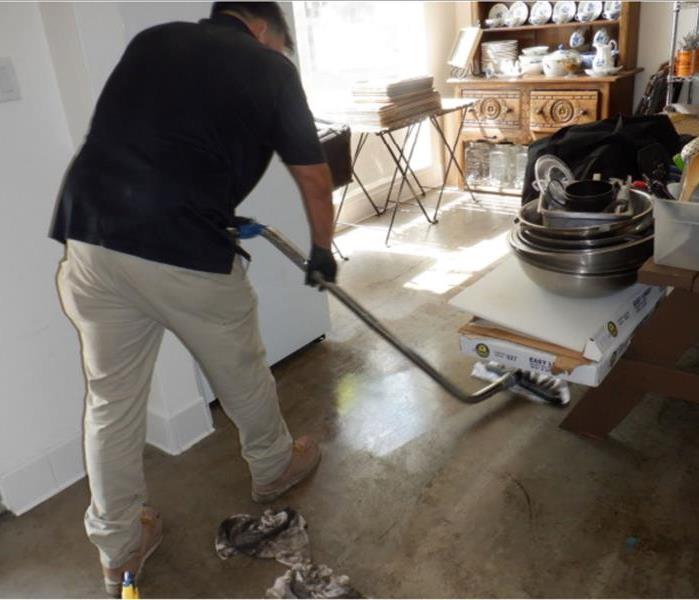 One of our fire damage technicians carefully cleaned ash and soot after a major fire.
One of our fire damage technicians carefully cleaned ash and soot after a major fire.
When the unpleasant situation of dealing with a fire arises, water damage is not far behind. There are many people that don’t realize with fire comes water – and lots of it.
Fire Damage Restoration Process
SERVPRO of Central Glendale takes pride in knowing that we can get fire restoration done no matter the size, day, or time. Our certified team of specialist not only know how to deal with fire but with water damage as well. As we all know, water puts out the flames. Unfortunately, the water from the fire department tends to completely soak all contents of the home or office. Valuables like rugs, curtains, clothing, furniture, and even fine art can be damaged.
The fire damage repair process doesn’t have to be painful. We follow SERVPRO’s strict protocols from beginning to end to ensure things are getting done fast in a productive way. This is what happens during a fire damage restoration process with us:
- Inspection - One of our certified team members will inspect your property thoroughly to locate the cause of the problem.
- Board-up/Tarping (If necessary) - In some instances, tarping a roof or boarding up a window or wall is necessary. This also maintains the security of the premises.
- Smoke/Soot Removal - SERVPRO of Central Glendale uses equipment made exclusively to pick up tiny particles of soot. The techniques to remove any smoke or soot in walls, ceilings, and other important surfaces can only be done through special certification.
Inventory Can Be Lost
Although typically not given much thought, salvage after a fire has a significant impact on a claim and the claim process. Losing your valuables can be stressful but inquiring with the insurance company can help to see what your options are. If there is sufficient insurance on the damaged goods, the insured still has the first choice in the handling of the goods whether they are salvageable or not. If the owner of the damaged goods has no insurance for his/her loss, every penny that can be recouped from the pile of debris is even more critical for the owner.
Local Fire Damage Experts
SERVPRO of Central Glendale is a local fire and water damage restoration company located in Glendale. We are nestled in the industrial neighborhood of Glendale where we are here to help you every step of the way. Give us a call now at 818-246-2200 today!
What To Do if Fire Damage Happens
5/31/2022 (Permalink)
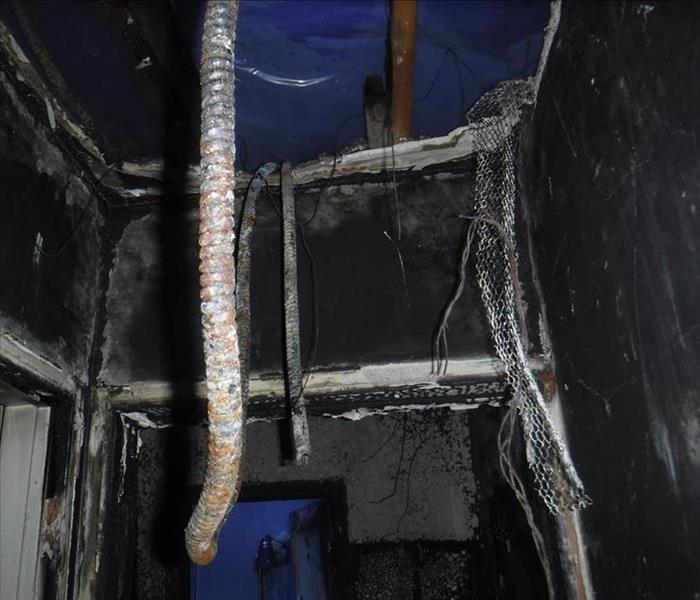 Fires can affect your life and damage your home or office. Call the experts at SERVPRO of Central Glendale to restore it back to the way it was.
Fires can affect your life and damage your home or office. Call the experts at SERVPRO of Central Glendale to restore it back to the way it was.
When Fire Damage Happens Call the Experts
A fire can be extremely damaging and harmful to your property. It's crucial to note that fire destroys the structure of the house in addition to causing massive smoke damage once it has been put out. SERVPRO of Central Glendale specializes in smoke cleanup and fire damage repair. Our experienced staff is well trained on the importance of acting quickly. For your property to be restored back to its original condition, we ask that you give us a call as soon as the firemen have done their job. As always, our first concern is for you, your safety, and your happiness.
Avoid Cleaning Fire and Smoke Damage Yourself
Another thing to keep in mind is that you should not try to clean or even touch the affected areas since doing so might make things worse. It may even cause the cost to rise. Here are some tasks we recommend you do (and don't do) before our fire technicians arrive:
- Do not attempt to wash any walls or clothing, doing so can smear the soot and settle it into the material.
- Do not try to shampoo your carpet or upholstery.
- Do not clean any electrical equipment that was near the fire, doing so can be extremely dangerous.
- Do not use any fans near the affected area as it will spread the smoke damage.
- Try to stay out of the affected areas as much as possible as it will make it harder for our team to work.
What To Do After the Damage is Done
All is not lost after a fire. There are things throughout the house you could do to reduce the
- Cover air registers
- Change HVAC filters
- Limit movement inside your home to prevent soot particles from further damaging your carpet.
- Protect all restorable items such as furniture, rugs and upholstery (note - only if they weren't directly affected by the fire).
Schedule a Fire Damage Inspection Today
If you have experienced recent fire damage in your home or office, schedule a fire damage inspection with us today. If you have any questions, give us a call today at 818-246-2200. Our staff will be more than happy to assist you 24 hours a day, 7 days a week.
The Dos and Don'ts of Fire Damage Safety
3/16/2022 (Permalink)
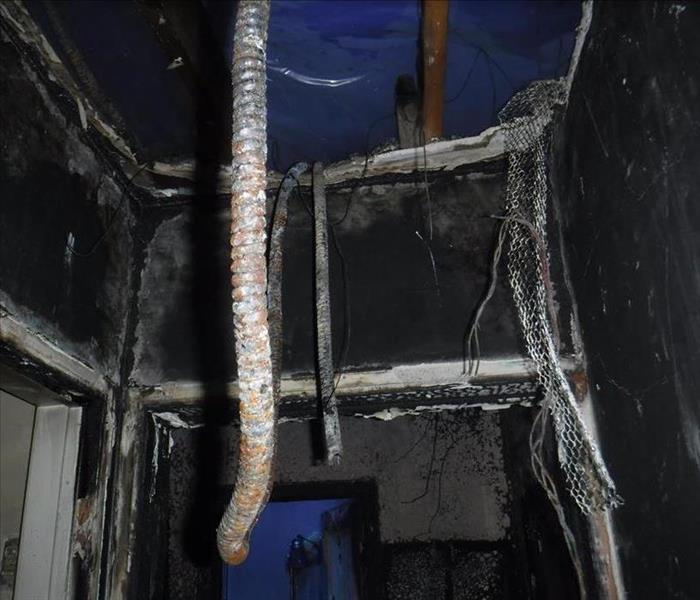 Fire damage safety is SERVPRO of Central Glendale's top priority. Follow these dos and don'ts to keep you and your family safe.
Fire damage safety is SERVPRO of Central Glendale's top priority. Follow these dos and don'ts to keep you and your family safe.
After any fire damage situation, the primary focus should be safety first. It is best to think of these important questions if there is ever a fire in or around the residence.
- Is it safe to stay in the house?
- Electrical and "slip and fall" hazards are the most prevalent concerns.
- Only do activities that are safe for you to perform.
- Wet materials can be heavier than usual. Be careful!
Smoke Damage Safety
With fires come smoke damage to cause more headaches. The questions above should always be applied if there are nearby fires. The smoke from neighboring fires can find its way inside the windows and under the doors. Smoke can leave a bad odor in curtains, upholstery, clothing, and even leave soot on the walls.
What To Do After a Fire
- Limit movement in the home to prevent soot particles from being embedded into upholstery and carpets.
- Keep hands clean so as not to further soil upholstery, walls, and woodwork.
- Place clean towels or old linens on rugs, upholstery, and carpet traffic areas.
- If electricity is off, empty freezer and refrigerator and prop doors open.
- Clean and protect chrome with a light coating of petroleum jelly or oil.
- Wash houseplants on both sides of the leaves.
- Change HVAC filter.
- Tape double layers of cheesecloth over air registers.
What NOT To Do After a Fire
- Don't attempt to wash any walls or painted surfaces or shampoo carpet or upholstery without contacting us.
- Don't attempt to clean any electrical appliances that may have been close to fire, heat, or water without consulting an authorized repair service.
- Don't use any canned or packaged food or beverages that may have been stored near the fire, heat, or water.
- Don't turn on ceiling fixtures if the ceiling is wet. The wiring may be damaged.
- Don't send garments to an ordinary dry cleaner. Improper cleaning may set the smoke odor. Inquire with us so we can get everything like it was.
If you have experienced fire or smoke damage to your home or office, give us a call at 818-246-2200 today. We can give you even more advice on your unique fire damage situation.
Kitchen Fire Caused Damage, but SERVPRO Restored It
2/7/2022 (Permalink)
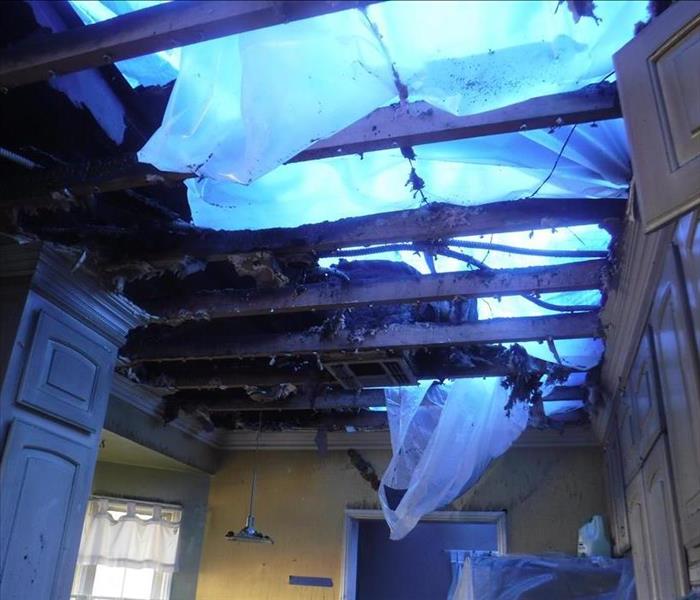 This ceiling had severe fire damage, but SERVPRO of Central Glendale's fire restoration technicians saved half of it, saving thousands of dollars.
This ceiling had severe fire damage, but SERVPRO of Central Glendale's fire restoration technicians saved half of it, saving thousands of dollars.
Flames can spread fast, but when the brave firefighters from the Glendale fire department put it out, SERVPRO's skilled fire damage technicians were there to clean up the ash and soot.
This residential home in Glendale, California suffered a grease fire in the kitchen. Grease fires are more common than people think and can spread very fast. The good news was that nobody got hurt from the fire, but it resulted in severe damage along the walls and ceiling.
It took the fire department a few hours, but they finally confirmed the fire was 100% out within the early morning hours. We received a phone call from the homeowner the next day to inquire about our fire damage services. She explained to our office what had happened and provided us with all the information we needed to begin the services. The homeowner contacted her home insurance company and provided us with the assigned adjuster's contact information.
Once the paperwork required by SERVPRO was signed by the homeowner, the office staff immediately got in touch with the insurance adjuster assigned to the fire claim. The office spoke to the insurance adjuster to get more information about the claim, while the fire damage restoration techs scoped the affected areas of the kitchen. SERVPRO of Central Glendale's goal is to save any part of the house that could be saved. The project manager concluded that half of the ceiling along with two walls had to be removed, but would be able to save the other two walls in the kitchen. The HVAC and air ducts had to be cleaned to improve the air quality and remove the smoke smell. The fire damage was drastic in the kitchen but luckily did not spread to other parts of the house.
As always, we worked with the insurance adjuster every single day (yes, weekends too). We provided them with plenty of photos and a report on everything our Glendale fire damage team had done. It took three weeks to complete the project, but by the end, the homeowner could not find one speck of ash or soot (which spreads and can get muddy). With our commercial-grade solutions, our fire technicians left her home spotless, while professionally removing the burned drywall and ceiling. To reduce the overpowering smoke smell, our team made sure to clean the air in the home from any odor from smoke damage using our specialty equipment.
If your home or office has experienced a fire recently or been affected by smoke damage, we are here to help. Give our office a call 24 hours a day, seven days a week at 818-246-2200. We are here to help reduce your worries and make a tragedy like this like there was never a fire to begin with.
What is the Fire and repair process?
8/12/2020 (Permalink)
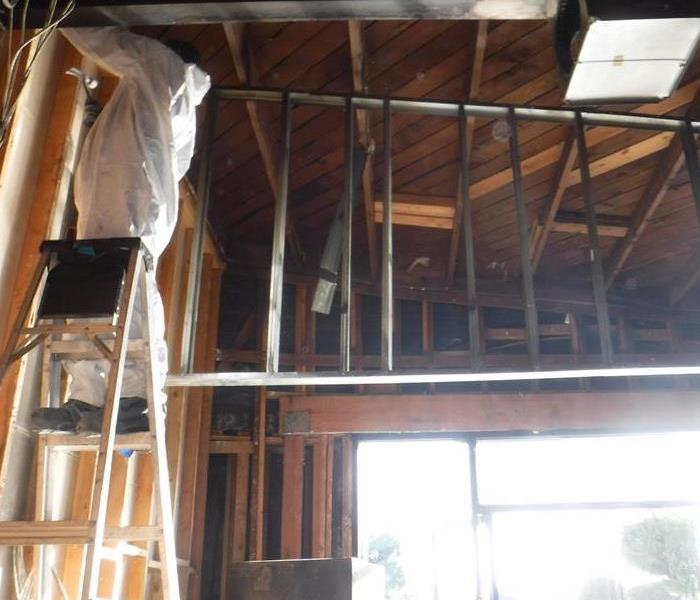 No matter what, we are here to help.
No matter what, we are here to help.
SERVPRO of Central Glendale takes pride is knowing that we can get the job done no matter the size, day or time. We don’t just specialize in Water restoration; did you know that we also specialize in Fire Damage Repair and restoration? Yes, we do it all! Here is a glimpse of what the Fire Damage repair process is:
1. Inspection One of our certified team members will inspect your property thoroughly to locate the root of the problem.
2. Board-up/Tarping (If necessary) In order to maintain security, our team will place tarps on the roofs and will board up anu damaged walls of windows.
3. Smoke/Soot Removal SERVPRO of Central Glendale uses specialized equipment and techniques to remove any smoke of soot in walls., Ceilings, and other important surfaces of your property.
If you have any questions regarding the process please gives us a call (818) 246-2200 We are happy to help!
Fire Damage Aftermath
7/29/2020 (Permalink)
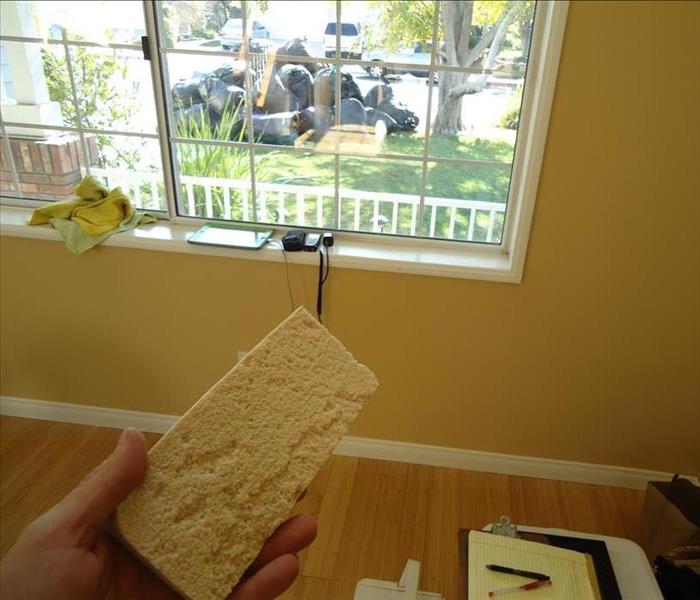 Smoke clean up in Calabasas, California.
Smoke clean up in Calabasas, California.
Dealing with the aftermath caused by a Fire is no fun, in fact it it’s very difficult, but we are here to help and make the process a lot less stressful.
We specialize in restoring contents damaged by Fire; we make sure we do our best to check what items we can restored to pre-condition. In order to do so we use different cleaning methods such as: Wiping and spraying, Wet Cleaning, Abrasive Cleaning etc.
As part of our process, we also specialize in Pack-outs, this is done if your home needs extensive cleaning due to the fire cleaning. In addition to cleaning your valuable belonging, we also specialize in Contents Claim Inventory Service (CCIS), this provides a very detailed list of all your belongings. We go room by room and make an inventory of your contents including photos of the items.
Call us for more information at (818) 246-2200 we are here to help!
Fire Damage Tips
7/24/2020 (Permalink)
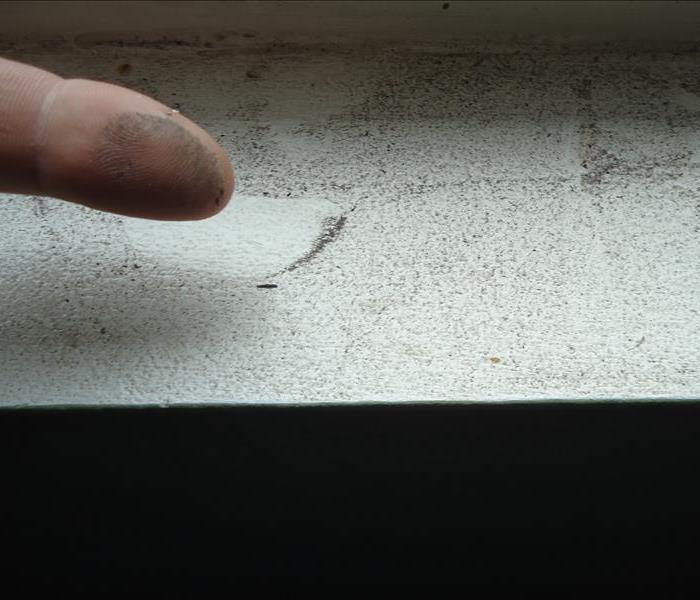 Smoke damage clean up in Calabasas, California
Smoke damage clean up in Calabasas, California
Fire can be extremely damaging and catastrophic to your home. It is important to know that after the fire is put out, the properties suffer from massive smoke damage. SERVPRO of Central Glendale we specialize in smoke clean up and fire damage repair. Our highly trained staff understands the urgency and measures that need to be implemented to ensure that your property is returned to its original state. As always, our main priority is you, your safety and your satisfaction.
One very important thing to remember is to not attempt to clean or even touch the area, doing so can actually make things worse and can lead the cost to be higher. Here are some things we recommend to be done prior to our arrival:
- Cover air registers
- Change HVAC filters
- Keep hands clean to avoid soiling woodwork, walls and upholstery
- Limit movement inside your home to prevent soot particles from further damaging your carpet.
- Protect all restorable items such as furniture, rugs, upholstery etc.
Why Ash is Messy When Cleaning
12/12/2019 (Permalink)
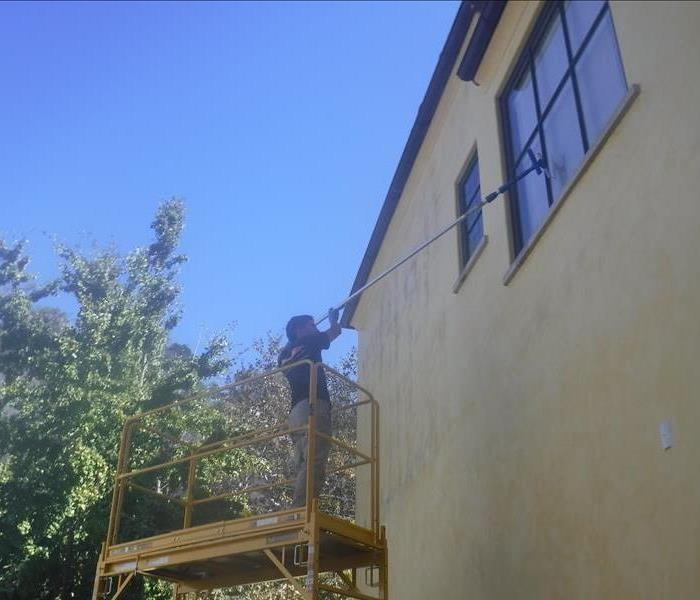 All of our technicians have received the best training and knowledge to get the job done.
All of our technicians have received the best training and knowledge to get the job done.
When a water or fire damage strikes, the aftermath can be stressful and a whole lot of messy. Did you know fire and water emergencies require major cleanup by specialists?
When a fire occurs, it is burning not only wood but everything else that makes up a structure. This includes insulation, paint, drywall, vinyl and plaster to name a few. Because these materials are not meant to be burned (the components can be harmful), the ash, soot and debris requires a specialist to handle it.
Ash for example is not easy to clean. Once wiped, it will smear and make the walls or furniture discolored. It can easily be sent up into the air when wiped just to settle back onto another section of your home or office. SERVPRO of Central Glendale‘s commercial grade cleaning products gets the ash cleaned fast and our technicians have gone through hours of training for the knowledge on how to do so.
If you are having trouble with the aftermath of a fire, please do not hesitate to give us a call at 818-246-2200 to speak to a specialist today.
What to Expect After a Fire
12/10/2019 (Permalink)
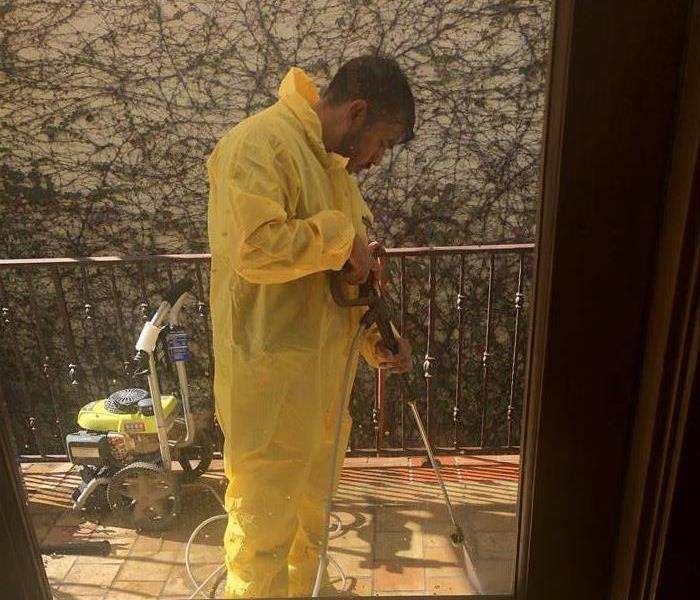 When a fire strikes, smoke and ash can get all over the outside of your home. Our technicians take care of that too!
When a fire strikes, smoke and ash can get all over the outside of your home. Our technicians take care of that too!
The experience of having a fire is like no other. It can be a very scary, confusing and hectic time for both you and your family. This is why SERVPRO of Central Glendale is here to help with all of your needs. We assure you our team has the right equipment and experience to bring you peace of mind.
After a fire, there is usually water in your home or office from those brave fire fighters putting the flames out. We understand what it takes to clean and restore the wet, ash covered walls, ceiling and even contents in your home or business. Our specialty cleaning products remove even the toughest odors with no lingering smoke odor.
It is unfortunate when the flames spread to the structure of your building, damaging drywall and paint. Our technicians are specially trained to perform demolition to the affected areas only, leaving anything that can be saved. If the right side of a wall was burned and the left unaffected, our techs will always make sure you know that it can be saved. Check out more of our fire damage services here.
After a Fire-The Dos and Don'ts
12/10/2019 (Permalink)
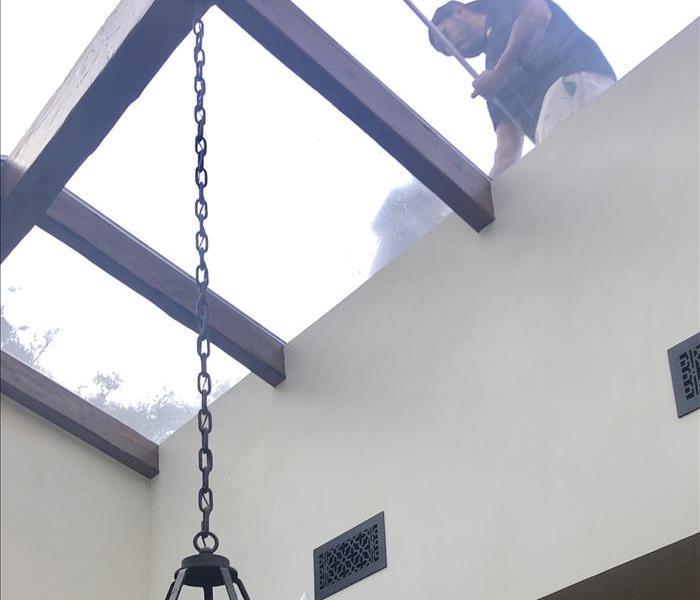 Knowing what to do after a fire will alleviate a stressful situation. Let us SERVPRO of Central Glendale take care of it for you!
Knowing what to do after a fire will alleviate a stressful situation. Let us SERVPRO of Central Glendale take care of it for you!
A fire in your home or business can be devastating and stressful. If you ever find yourself in this situation, here are some tips on what to do and what not to do while you wait for your local SERVPRO to arrive on scene.
What to Do After a Fire
- To avoid further damage to your upholstery, make sure hands are clean when handling sofas, chairs, woodwork and walls
- A safe way to clean and protect chrome around the house or office is by applying petroleum jelly or oil to them
- Place clean towels or linen where there are high traffic areas
- Empty out the refrigerator and freezer while propping open the doors if the electricity is off
- Change the HVAC filter in your building
- Take double layers of cheese cloths and tape them over air registers to avoid constant debris blowing out into a room
What NOT to Do After a Fire
- Never attempt to clean electronic appliances that may have been close to the fire, heat or water (from the fire department) without consulting an authorized professional first
- Do not attempt to wash or paint any walls after a fire. There is guaranteed to be ash on the walls which needs to be removed with our sponges (designed specifically for fire ash and soot removal)
- Don’t turn on any ceiling fixtures when the ceiling is wet. There may be damaged wires that are not visible
- Do not send clothing to a regular dry cleaning service. Improper cleaning of garments after a fire can cause the smoke smell to settle into the material
- Never eat or drink any canned / boxed food or beverages that may have been stored near the fire, heat or water
If you have any more questions regarding what and what not to do after a fire, contact us at 818-246-2200 and we will be happy to answer!
West Hills Smoke and soot clean up
8/13/2019 (Permalink)
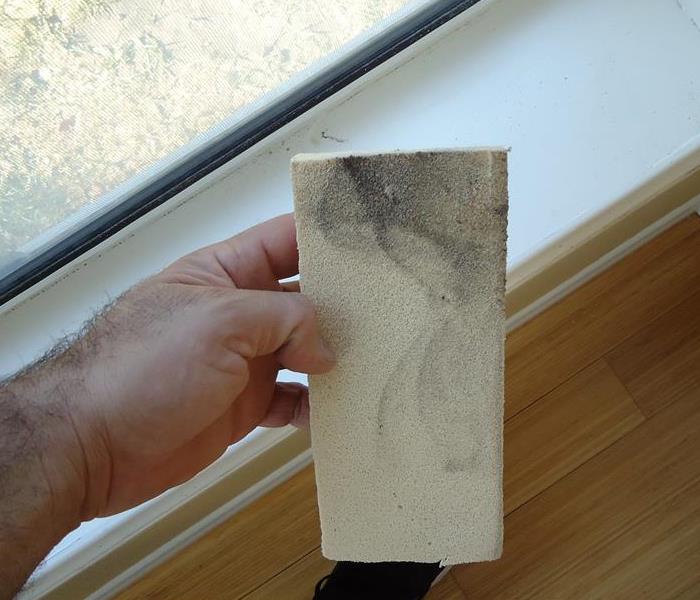 Smoke Damage Can Cause a Pervasive Odor in Your Home.
Smoke Damage Can Cause a Pervasive Odor in Your Home.
Smoke and soot is very invasive and can penetrate various cavities within your home, causing hidden damage and odor. Our smoke damage expertise and experience allows us to inspect and accurately assess the extent of the damage to develop a comprehensive plan of action.
Smoke and soot facts:
- Hot smoke migrates to cooler areas and upper levels of a structure.
- Smoke flows around plumbing systems, seeping through the holes used by pipes to go from floor to floor.
- The type of smoke may greatly affect the restoration process.
Different Types of Smoke
There are two different types of smoke–wet and dry. As a result, there are different types of soot residue after a fire. Before restoration begins, SERVPRO of Central Glendale will test the soot to determine which type of smoke damage occurred. The cleaning procedures will then be based on the information identified during pretesting. Here is some additional information:
Wet Smoke – Plastic and Rubber
- Low heat, smoldering, pungent odor, sticky, smeary. Smoke webs are more difficult to clean.
Dry Smoke – Paper and Wood
- Fast burning, high temperatures, heat rises therefore smoke rises.
Protein Fire Residue – Produced by evaporation of material rather than from a fire
- Virtually invisible, discolors paints and varnishes, extreme pungent odor.
Our Fire Damage Restoration Services
Since each smoke and fire damage situation is a little different, each one requires a unique solution tailored for the specific conditions. We have the equipment, expertise, and experience to restore your fire and smoke damage. We will also treat your family with empathy and respect and your property with care.
Have Questions about Fire, Smoke, or Soot Damage?
Call Us Today – (818) 246-2200
Fire Damage Emergency Tips
11/21/2018 (Permalink)
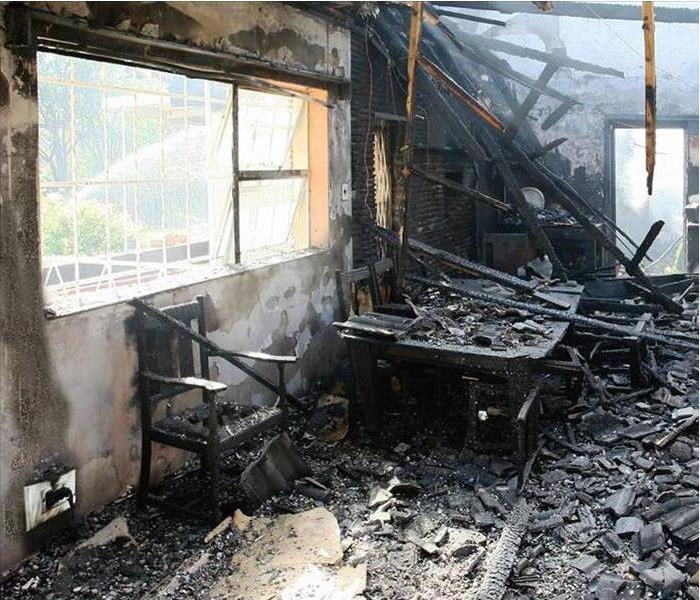 Residential Fire Damage
Residential Fire Damage
After any fire damage situation, your primary focus should be safety first:
- Is it safe to stay in the house?
- Electrical and "slip and fall" hazards are some of the most prevalent concerns.
- Only do activities that are safe for you to perform.
- Wet materials can be VERY heavy. Be careful!
Have Smoke or Fire Damage? Call (818) 246-2200!
What To Do After A Fire
- Limit movement in the home to prevent soot particles from being embedded into upholstery and carpets.
- Keep hands clean so as not to further soil upholstery, walls and woodwork.
- Place clean towels or old linens on rugs, upholstery and carpet traffic areas.
- If electricity is off, empty freezer and refrigerator and prop doors open.
- Clean and protect chrome with light coating of petroleum jelly or oil.
- Wash houseplants on both sides of leaves.
- Change HVAC filter.
- Tape double layers of cheesecloth over air registers.
What NOT To Do After A Fire
- Don't attempt to wash any walls or painted surfaces or shampoo carpet or upholstery without contacting us.
- Don't attempt to clean any electrical appliances that may have been close to fire, heat or water without consulting an authorized repair service.
- Don't use any canned or packaged food or beverages that may have been stored near the fire, heat or water.
- Don't turn on ceiling fixtures if ceiling is wet. The wiring may be damaged.
- Don't send garments to an ordinary dry cleaner. Improper cleaning may set smoke odor.
Why You Should Clean Your Dryer Vents!
11/21/2018 (Permalink)
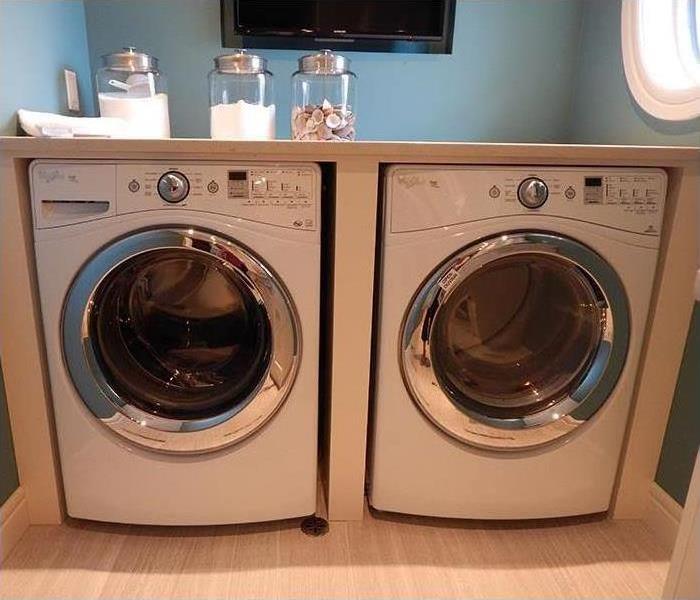 Dryer Vent Cleaning Can Prevent Fires
Dryer Vent Cleaning Can Prevent Fires
According to FEMA, failure to clean dryers and dryer vents causes 34% of home dryer fires. Home dryer fires cause $35 million in property loss and can even cause injury or death.
To reduce the risk of these fires happening in your home, clean dryer vents regularly. Every few months be sure to wash the lint filter with detergent to get rid of residue buildup that might be impeding airflow. Also clean the whole exhaust duct line yearly to reduce clogs and risk of fire.
Other tips for keeping your dryer vents clean from the National Fire Protection Agency include cleaning the lint filter before and after each load, and making sure the outdoor vent flap will open and is not restricted by snow, a bird’s nest, or other potential obstacles.
If you have a high efficiency dryer, look for easy-access panels and check inside for any additional lint buildup.
Pet Fire Safety
10/11/2018 (Permalink)
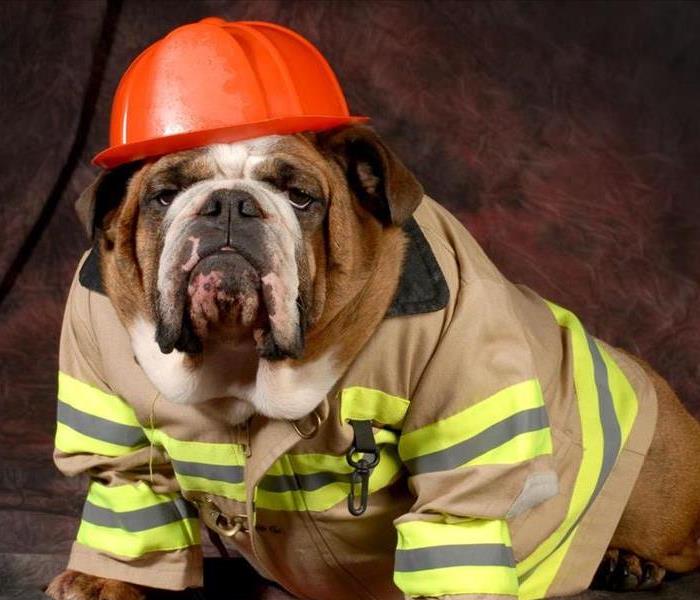 Never leave pets alone around an open flame. If your pet is rowdy, it's best to avoid candles.
Never leave pets alone around an open flame. If your pet is rowdy, it's best to avoid candles.
Prevent Your Pets from Starting Fires
The National Fire Protection Association estimates that nearly 1,000 home fires each year are accidentally started by the homeowners' pets.
The American Kennel Club and ADT Security Services have joined forces to provide the following tips:
- Extinguish Open Flames - Pets are generally curious and will investigate cooking appliances, candles, or even a fire in your fireplace. Ensure your pet is not left unattended around an open flame and make sure to thoroughly extinguish any open flame before leaving your home.
- Remove Stove Knobs - Be sure to remove stove knobs or protect them with covers before leaving the house - a stove or cook top is the number one piece of equipment involved in your pet starting a fire.
- Invest in Flameless Candles - These candles contain a light bulb rather than an open flame, and take the danger out of your pet knocking over a candle. Cats are notorious for starting fires when their tails turn over lit candles.
- Secure Young Pets - keep them confined away from potential fire-starting hazards when you are away from home such as in crates or behind baby gates in secure areas.
Help Firefighters Help Your Pets- Keep pets near entrances when away from home. Keep collars on pets and leashes at the ready in case firefighters need to rescue your pet. When leaving pets home alone, keep them in areas or rooms near entrances where firefighters can easily find them.
- Affix a pet alert window cling and write down the number of pets inside your house and attach the static cling to a front window. This critical information saves rescuers time when locating your pets. Make sure to keep the number of pets listed on them updated.
Fire!
1/15/2018 (Permalink)
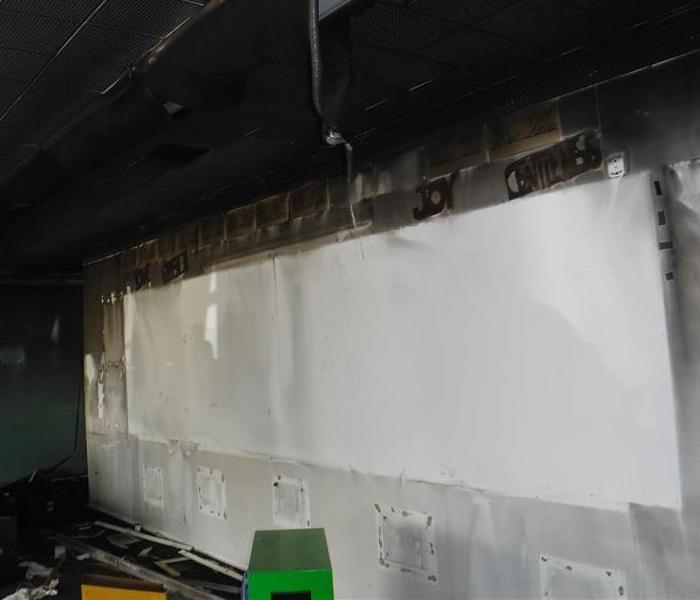 Fire in the classroom.
Fire in the classroom.
A fish tank in a classroom exploded overnight caused half the classrooms and the basement to catch on fire in a school in the Los Angeles area. This picture shows that one of the classrooms that got more damaged than any other rooms. SERVPRO of Central Glendale was called in by the principle of the school the very next day within thirty minutes we have arrived to the damage areas. Fire is very dangerous and its usually hard to get rid of when it spreads rapidly. The process of the work took about a week and two days to finish. The owner was thrilled when he saw the aftermath of the work we did for them and he said "The classrooms look amazing and thank you again!"
Smoke and Suit up
1/11/2018 (Permalink)
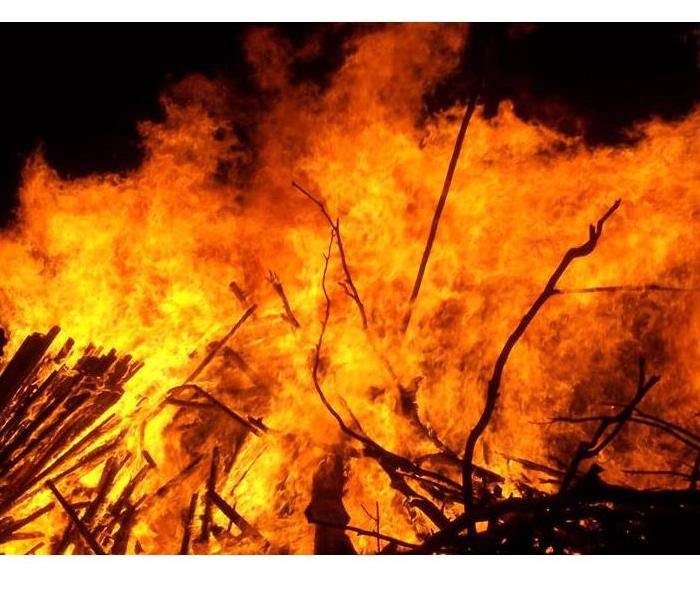 SERVPRO of Central Glendale is on 24/7!
SERVPRO of Central Glendale is on 24/7!
Smoke and soot is very invasive and can penetrate various cavities within your home, causing hidden damage and odor. Our smoke damage expertise and experience allows us to inspect and accurately assess the extent of the damage to develop a comprehensive plan of action.
Smoke and soot facts:
Hot smoke migrates to cooler areas and upper levels of a structure.
Smoke flows around plumbing systems, seeping through the holes used by pipes to go from floor to floor.
The type of smoke may greatly affect the restoration process.
Different Types of Smoke
There are two different types of smoke–wet and dry. As a result, there are different types of soot residue after a fire. Before restoration begins, SERVPRO of Central Glendale will test the soot to determine which type of smoke damage occurred. The cleaning procedures will then be based on the information identified during pretesting. Here is some additional information:
Wet Smoke – Plastic and Rubber
Low heat, smoldering, pungent odor, sticky, smeary. Smoke webs are more difficult to clean.
Dry Smoke – Paper and Wood
Fast burning, high temperatures, heat rises therefore smoke rises.
Protein Fire Residue – Produced by evaporation of material rather than from a fire
Virtually invisible, discolors paints and varnishes, extreme pungent odor.
Our Fire Damage Restoration Services
Since each smoke and fire damage situation is a little different, each one requires a unique solution tailored for the specific conditions. We have the equipment, expertise, and experience to restore your fire and smoke damage. We will also treat your family with empathy and respect and your property with care.
Have Questions about Fire, Smoke, or Soot Damage?
Call Us Today – (818) 246-2200
Prepare, prepare, prepare!
10/13/2017 (Permalink)
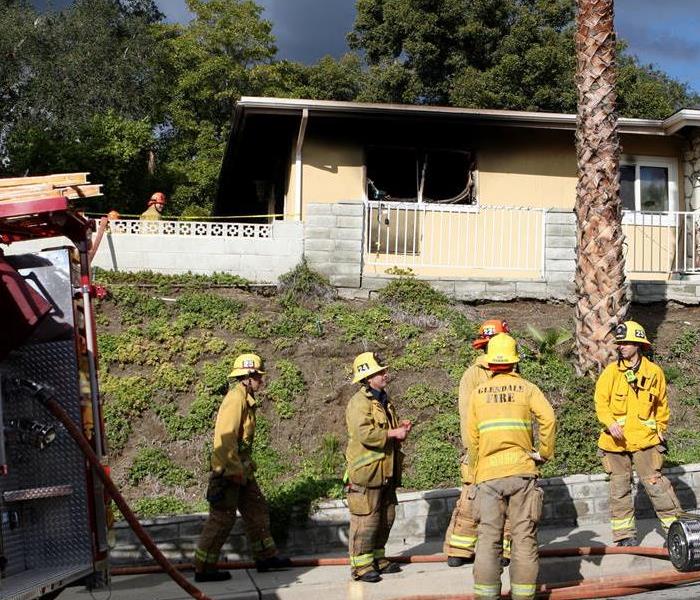 Most electrical fires are caused by faulty electrical outlets and old, outdated appliances
Most electrical fires are caused by faulty electrical outlets and old, outdated appliances
In just two minutes, a fire can become life-threatening. In five minutes, a residence can be engulfed in flames.
Learn About Fires
- Fire is FAST! In less than 30 seconds a small flame can turn into a major fire. It only takes minutes for thick black smoke to fill a house or for it to be engulfed in flames.
- Fire is HOT! Heat is more threatening than flames. Room temperatures in a fire can be 100 degrees at floor level and rise to 600 degrees at eye level. Inhaling this super-hot air will scorch your lungs and melt clothes to your skin.
- Fire is DARK! Fire starts bright, but quickly produces black smoke and complete darkness.
- Fire is DEADLY! Smoke and toxic gases kill more people than flames do. Fire produces poisonous gases that make you disoriented and drowsy. Asphyxiation is the leading cause of fire deaths, exceeding burns by a three-to-one ratio.
Before a Fire
Create and Practice a Fire Escape Plan
In the event of a fire, remember that every second counts, so you and your family must always be prepared. Escape plans help you get out of your home quickly.
Twice each year, practice your home fire escape plan. Some tips to consider when preparing this plan include:
- Find two ways to get out of each room in the event the primary way is blocked by fire or smoke.
- A secondary route might be a window onto a neighboring roof or a collapsible ladder for escape from upper story windows.
- Make sure that windows are not stuck, screens can be taken out quickly, and that security bars can be properly opened.
- Practice feeling your way out of the house in the dark or with your eyes closed.
- Teach children not to hide from firefighters.
Smoke Alarms
A working smoke alarm significantly increases your chances of surviving a deadly home fire.
- Install both ionization AND photoelectric smoke alarms, OR dual sensor smoke alarms, which contain both ionization and photoelectric smoke sensors.
- Test batteries monthly.
- Replace batteries in battery-powered and hard-wired smoke alarms at least once a year (except non-replaceable 10-year lithium batteries).
- Install smoke alarms on every level of your home, including the basement, both inside and outside of sleeping areas.
- Replace the entire smoke alarm unit every 8-10 years or according to manufacturer’s instructions.
- Never disable a smoke alarm while cooking – it can be a deadly mistake.
Smoke Alarm Safety for People with Access or Functional Needs
- Audible alarms for visually impaired people should pause with a small window of silence between each successive cycle so that they can listen to instructions or voices of others.
- Smoke alarms with a vibrating pad or flashing light are available for the hearing impaired. Contact your local fire department for information about obtaining a flashing or vibrating smoke alarm.
- Smoke alarms with a strobe light outside the home to catch the attention of neighbors, and emergency call systems for summoning help, are also available.
Inventory Loss
8/24/2017 (Permalink)
The more difficult part is establishing the accurate salvage value of the damaged goods.
Although typically not given much thought, salvage has a significant impact on a claim and the claim process. It can either be a means to be fully indemnified for a loss, or potentially impede the recovery. If there is sufficient insurance on the damaged goods, the insured still has the first choice in the handling of the goods whether they are salvageable or not. After all, it’s his/her goods until paid for by the insurance company. If the owner of the damaged goods has no insurance for his/her loss, every penny that can be recouped from the pile of debris is even more critical for the owner.
The Basics of Salvage
The dictionary describes “salvage” as
- The act of saving imperiled property from loss.
- The property so saved.
- Something saved from destruction or waste and put to further use.
The owner of damaged goods (insured or not) will always want to recover as much as possible for the salvageable items. How that is accomplished could fill volumes of books, as almost every salvage effort is unique. This is because the major factors that affect salvage value are market conditions, and time and place of loss. Each of these components is ever-changing.
The following scenarios provide a basic look at salvage principles.
1. Salvage Turned Over to the Insurance Company
Insured A has $100,000 in inventory value. They have $100,000 in coverage without
a coinsurance clause or a deductible in the policy. In the event of a total loss to the coinsurance clause or a deductible in the policy. In the event of a total loss to the insured property, the insured would be paid the policy limits of $100,000 and surrender title and ownership of the damaged inventory. The inventory, now owned by the insurance company, would be removed by them and salvaged if possible.
2. Salvage Retained by the Insured
Insured A has $100,000 in inventory value. They have $100,000 in coverage without a coinsurance clause or a deductible in the policy. In the event of a loss to the insured property the insured decides to retain and attempt to salvage the inventory themselves.
The insurance company places a salvage value of $30,000 on the damaged inventory. The $30,000 value is deducted from the policy limits of $100,000 and the insured would be paid $70,000. It is then up to the insured to salvage the inventory.
3. Salvage in an Underinsured Loss
Insured A has $100,000 in inventory value. They only have $50,000 in coverage and no coinsurance clause or a deductible in the policy. In the event of a total loss the insured is paid $50,000 — the limit of liability of their policy. The insured also retains the damaged inventory and, if salvageable, those monies contribute to the reduction of the policyholder’s uninsured loss. Salvage becomes a means to become more fully in terms of the consignment with respect to damage while the goods are in the “care, custody, and control” of the insured?






 24/7 Emergency Service
24/7 Emergency Service






